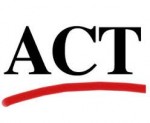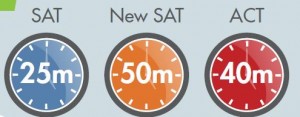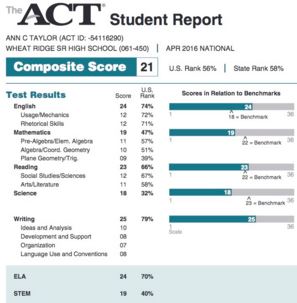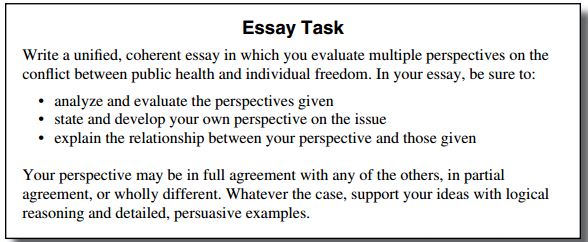The ACT Writing section (aka the essay) is new for the 2015-2016 school year. 
What’s the difference between the old and new ACT essay question?
The old essay prompt was relevant to teenage issues and asked students to consider issues such as student dress code, curfew, whether or not students should be required to take PE or arts classes, or even whether or not texting while driving laws should be enforced. In other words, as the ACT puts it, it was a persuasion essay.
The new essay is an exercise in both persuasion and analysis. In one essay, students are given three perspectives on an issue and asked to “evaluate and analyze” those three perspectives, “state and develop” their own perspective, and “explain the relationship” between their perspective and the given perspectives. Students can then choose to agree with one of those viewpoints or come up with their own, “new” viewpoint. The new ACT essay prompt asks students to do a lot more than it used to!
This is a lot to ask high school students to do, especially in a time environment! This is why students MUST practice this new essay prompt and strategy to make sure you hit all of the required parts of the question in an organized, well-written essay.
Will the new ACT essay still be optional?
Yes. Students can still choose whether or not they want to take the essay, and it will still be the last section of the test for students who choose to take it. But, and this is a big BUT, many college require a writing score, from either the SAT or ACT, so it is recommended to register for the ACT with Writing.
How can I prepare for the new ACT essay?
Magoosh High School Blog suggests: “Practice, planning, and drafting an essay based on the sample essay prompts above. Do them within the time limit. Then review the sample essays posted by the ACT on the official ACT prompt and the rationale for the scores they received. Review the rubric the graders will be using. This knowledge is power. Remember, you are writing for the graders, so give them what they want.”
What are the top tips for success on the new ACT essay? 
Here are tips from Magoosh on what will help you get your best essay score:
- Your intro paragraph should introduce the perspectives from the answer and include a thesis statement that states which perspective you like and why you believe it.
For example, based on the released ACT example prompt on Intelligent Machines here, this could potentially be your introduction:
Although intelligent machines might cause us to question what makes us human, it is too extreme to say that they cause us to either to lose our humanity or push us to become super-human. Humans and machines can work in concert: machines can be employed to take on tasks that are menial, tedious, and time-consuming, leaving humans free to work on tasks that require a human mind and spirit.
Notice that the first sentence summarizes the first and third perspectives in the prompt and the thesis statement agrees with the second. This sets up a structure for your essay in which you will evaluate the three perspectives and explain why you agree with one of them.
- Choose one of the given three perspectives to agree with (at least mostly) and avoid the option to present your own.
With three different perspectives to evaluate and a limited amount of time to write, you are going to be able to cover more ground if you choose to agree with one of provided perspectives. Three viewpoints is already a lot to evaluate. If you choose to present your own viewpoint, this means you now have to elaborate on FOUR perspectives. You can get a perfect score by agreeing with one of the given perspectives. Don’t make your life harder.
- Know your essay structure of 5 paragraphs in advance. Here’s one organization strategy that should work well:
- Brief intro paragraph (2-3 sentences)
- Evaluation of the first perspective you did not choose with specific examples
- Evaluation of other perspective you did not choose with specific examples
- Evaluation of the perspective you agree with and further development on why you agree with it using specific examples (this should be a longer paragraph than the first two, or it could be split into two paragraphs)
- Brief conclusion (approx 2 sentences): make a final case for your argument
This structure ensures that you answer all three parts of the question: evaluating the three perspectives, developing your own, and explaining the relationship between your perspective and the others.
- Give VERY specific examples
This has always been the case on the ACT essay. For each of the three perspectives, make sure you give specific examples. And the more specific they are, the better. You don’t need a lot–two or three good ones do the trick. Examples from historical and contemporary events and circumstances tend to go over best. Personal examples can also work, but graders seem to be biased towards outside examples–they seem to carry more weight.
- Leave time to proofread at the end
Since “Language Use” is its own separate grading category now, it is worth your time to catch any errors you may have inadvertently made while while writing quickly.
Will the time limit be the same as it is now?
The ACT knows it’s asking y ou to do more, and so it is giving you a little more time to think and plan. The time limit for the old essay was 30 minutes. You will now have a 40 minute time limit to write the new essay.
ou to do more, and so it is giving you a little more time to think and plan. The time limit for the old essay was 30 minutes. You will now have a 40 minute time limit to write the new essay.
Will the scoring be the same as it is now?
No! But this doesn’t really matter to students until colleges figure out how/what they are expecting of applicants.
Previously, on the old essay, students received an essay score from 1-6 from two different readers, which was then combined to be a total of 2-12.
Now, instead students will receive a score out of 36, which will make it similar to the other sections of the test. Student will also receive what are called domain scores out of 12 in four categories: Ideas and Analysis, Development and Support, Organization, and Language Use and Conventions. Weirdly, these scores do not add up to the overall score, but are instead supposed to give more information on the writer’s strengths and weaknesses. Students will receive a score out of 6 from two grades on each of these domains, but then those points will be converted to a scaled score, out of 36. See rubric here.
sections of the test. Student will also receive what are called domain scores out of 12 in four categories: Ideas and Analysis, Development and Support, Organization, and Language Use and Conventions. Weirdly, these scores do not add up to the overall score, but are instead supposed to give more information on the writer’s strengths and weaknesses. Students will receive a score out of 6 from two grades on each of these domains, but then those points will be converted to a scaled score, out of 36. See rubric here.
ACT Preparing for the Test– full practice test, essay prompt and answers
SAT or ACT Prep– dates for tests and private tutoring




